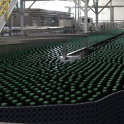|
Josh Wow posted:You don't need to nerd out, but you should do a little more than just throw in some gypsum and hope for the best. Just go to AWESOME! Thank you so much for that link. Looks like I'll need to add a bit more than I thought but should still be inexpensive. I'm just looking for an amount to add to each batch to make a neutral water regardless of style, and this is going to help a ton.
|
|
|
|

|
| # ? Jun 6, 2024 14:55 |
|
.
almost fucked around with this message at 11:01 on Dec 15, 2013 |
|
|
|
almost posted:Also how should I check SG? By putting the hyrometer into the fermenter or taking a sample out? Can I put the sample back into the fermenter? Take a sample out, then drink it after testing.
|
|
|
|
almost posted:For my high ABV cider that I'm bottling still, do I need to degas it like a wine? How much head space should there be when bottling? I fill my bottle to the base of the neck. The spring-loaded bottle filler wand does this for me automatically. Let the bottles sit upright for 2 days to release pressure and then store on their sides to keep the cork moist. Campden (sulfites) will stop an active fermentation. Potassium sorbate will prevent a new fermentation or fermentation restarting by interfering with yeast reproduction. Neither is strictly necessary as long as you wait to bottle until fermentation is finished by measuring no change in gravity over a few days time. However, sulfites can help protect the finished product from oxidation. Use a sample taker or wine thief to fill up your hydrometer test tube. Don't put the sample back in. It isn't worth the risk of infection for the small loss of cider.
|
|
|
|
.
almost fucked around with this message at 11:05 on Dec 15, 2013 |
|
|
|
almost posted:Thanks for the info guys. I don't know how you'd attach it to the auto siphon. I put my bottling wand on the spigot of a bottling bucket with a few inches of tubing. The flexibility helps when you get near the bottom and need to tilt the bucket to get the last bit. quote:Oh? I thought that stuff was supposed to dissipate completely. Can it still protect from oxidation if you bottle it afterward, or do you just mean if you want to leave it to age in the carboy you dropped the tablets into? SO2 binds with stuff in the wine (or cider or whatever). You can go down the rabbit hole here: http://morewinemaking.com/public/pdf/so2.pdf
|
|
|
|
Cpt.Wacky posted:I don't know how you'd attach it to the auto siphon. I put my bottling wand on the spigot of a bottling bucket with a few inches of tubing. The flexibility helps when you get near the bottom and need to tilt the bucket to get the last bit. Just connect the wand to the end of the tubing coming off of the autosiphon. It's an easy way to bottle if you don't have a bucket with a spigot.
|
|
|
|
My girlfriend got me a wort chiller. I'm looking forward to chilling some wort.
|
|
|
|
Got my beer and hops. Thanks Santa!
|
|
|
|
.
almost fucked around with this message at 11:01 on Dec 15, 2013 |
|
|
|
I've got an IPA i'm brewing up that's been the same way. It started out really intense, then lightened up to a bubble every less than two seconds, and has been sitting there steadily for almost 13 days. It's the fermentation that never ends! It's fine though.. there's a lot to be eaten.
|
|
|
|
.
almost fucked around with this message at 11:01 on Dec 15, 2013 |
|
|
|
almost posted:Also are there any problems with a fermentation that can cause the gravity to go down but not actually increase the alcohol content? That's my biggest worry, that it won't be as strong as I think it is. Here's a super basic fermentation 101: Your Original Gravity is 1.100, which is a measurement of the amount of sugar that's dissolved in the liquid you have. Fermentation is when the yeast eat that sugar and crap out CO2 and ethanol. So your gravity dropping means there has to be ethanol present. You'll get your final ABV by subtracting your Final Gravity from your OG using a formula or an online calculator. As for your banana and apple esters and whether they're appropriate, that depends on what yeast strain you used. Certain strains are supposed to make those flavors, and other strains make them when they're stressed. My suggestion is to look up the yeast strain you used on the manufacturer's website, they should have a recommended temperature range. Slowly bring your yeast to the middle of that temperature range if you can. Also if you leave your cider in primary for a few weeks the yeast will clean up a lot of off flavors. So if you ever have a cider/beer with some flavors you don't like just leave it in the fermentor on the yeast for a little longer and see if that helps.
|
|
|
|
.
almost fucked around with this message at 11:01 on Dec 15, 2013 |
|
|
|
So the other day I bottled a pale ale that I had going. When I took the final gravity and tasted the uncarbed beer, it tasted great. We used citra hops and Thames Valley yeast, just all around great. However, I'm afraid we screwed up in one regard: We used the dishwasher to sanitize the bottles, and the cycle took longer than I expected. So in the meantime I had the beer racked into the bottling bucket, sitting open to the air for about half an hour, after which I covered with plastic wrap, and it sat for maybe another hour. We then bottled the beer. The "leftover" bottle we had, we left for my mom to taste when she got home, plugged with one of those rubber wine-saver corks. I tasted a little bit of that later (2-3 hours), and detected some oxidation, certainly not as fresh as when I had taken the FG. It wasn't "ruined" but just not as good. So, did I screw up the whole batch by leaving it in the bottling bucket for so long, or was the oxidation just from that one bit sitting in a half-full bottle? I'm half tempted to open up one of the bottles early to see if it tastes ok.
|
|
|
|
almost posted:Stuff Go and read http://www.howtobrew.com/section1/chapter8.html to understand the basics of fermentation. It's based towards beer but cider fermentation is close enough that all the basics will apply. LogisticEarth posted:So, did I screw up the whole batch by leaving it in the bottling bucket for so long, or was the oxidation just from that one bit sitting in a half-full bottle? I'm half tempted to open up one of the bottles early to see if it tastes ok. The yeast will scavenge some/all of the oxygen when they carbonate the beer in the bottle, so I wouldn't worry about it too much.
|
|
|
|
almost posted:The reason I was wondering is because the yeast/other infections must be using something to make those odors/tastes or other unwanted chemicals, and the only thing that's really in there is the stuff that's there to be made into alcohol. So in the process of these esters being made, is sugar being consumed that would otherwise be converted into ethanol? And if so wouldn't that throw off the gravity reading? This question goes for other infections and unintended byproducts as well, not just esters. Tasty chemicals are present in beer in the parts per billion to several hundred parts per million range. So for a typical cider at say 10% abv, going by weight you have 92% water and sugar, 8% booze, and up to .01-.05% random tasty chemicals. You can't really see that on a hydrometer so everyone pretends it doesn't exist outside of your nose. The only thing you need to worry about scavenging your booze is vinegar, in which case you may not have booze anymore but do have delicious homemade vinegar.
|
|
|
|
.
almost fucked around with this message at 11:01 on Dec 15, 2013 |
|
|
|
So if my water is treated with chlorine, should I treat with campden tablets to presumptively treat for chloramine? Also, if I'm just given a ph in my water report of 7.54 and a hardness of 289, can I figure out my bicarbonate and calcium levels? Doing my first all grain batch in a couple days and trying to decide whether or not to buy DI water to avoid any possibility of homebrewer's tang.
|
|
|
|
I wouldn't buy DI or distilled water, but it may be worth it to go get some drinking water or spring water. I always get weird beer when I use tap water since it has chloramines and tons of minerals. If you read up a ways, I was asking the same question about using my RO/DI filter and it came down to having to add salts to the water.
|
|
|
|
YASD posted:So if my water is treated with chlorine, should I treat with campden tablets to presumptively treat for chloramine? Also, if I'm just given a ph in my water report of 7.54 and a hardness of 289, can I figure out my bicarbonate and calcium levels? Doing my first all grain batch in a couple days and trying to decide whether or not to buy DI water to avoid any possibility of homebrewer's tang. Campden (or any sulfite source) will treat either chlorinated or chloriminated water. I use Campden because it's easy - one tab, crushed, treats all my water (strike and sparge) for the batch, up to 20 gallons. I don't think pH and total hardness are enough to figure out mineral content. 289 is pretty hard, but if it tastes good to drink, you can make good beer with it. Depending on the mineral content, you might get slightly reduced mash efficiency, increased hop bitterness, or any of a number of other effects - whole books are written about this stuff. Many of the world's classic styles are reactions to the local water conditions. Dry Irish stouts are a reaction to the alkaline water in Dublin. Pilsners are a reaction to the very soft water in Plzn. Burton ales are a reaction to the very high mineral content (~600ppm, if I recall correctly) of the water in Burton-on-Trent. You can brew good beer with any water that does not actually taste bad, but you may have to choose and tweak recipes to account for your local conditions. Or, if you want to emulate certain styles, you may have to start with RO or DI water and add minerals to suit, or just mix your local water with RO or DI to dilute it.
|
|
|
|
Tomorrow I'm going to brew a Consecration clone but the kit I bought came with some corn sugar and candi syrup which I've never used before. It didn't really come with detailed instructions, when exactly should I be adding these, near the end of the boil?
|
|
|
|
Sirotan posted:Tomorrow I'm going to brew a Consecration clone but the kit I bought came with some corn sugar and candi syrup which I've never used before. It didn't really come with detailed instructions, when exactly should I be adding these, near the end of the boil? Yep. Use at flameout, mix it in well, proceed as normal.
|
|
|
|
I forgot to get the yeast for my Witbier over the weekend and the only homebrew store open is 45 minutes away and I'd rather not travel there if it's not necessary. I'm brewing a witbier using Wyeast 3944, Belgian Witbier Yeast in a witbier with an OG of 1.050 for 5 gallons. Is it necessary to run to the store to make a starter today or will a 1 month old smack pack be sufficient?
|
|
|
|
Midorka posted:I forgot to get the yeast for my Witbier over the weekend and the only homebrew store open is 45 minutes away and I'd rather not travel there if it's not necessary. I'm brewing a witbier using Wyeast 3944, Belgian Witbier Yeast in a witbier with an OG of 1.050 for 5 gallons. Is it necessary to run to the store to make a starter today or will a 1 month old smack pack be sufficient? Is it a month from the store or a month expired? Either way, it's probably good. Use it and if it doesn't ferment get another pack to kickstart it again.
|
|
|
|
Midorka posted:I forgot to get the yeast for my Witbier over the weekend and the only homebrew store open is 45 minutes away and I'd rather not travel there if it's not necessary. I'm brewing a witbier using Wyeast 3944, Belgian Witbier Yeast in a witbier with an OG of 1.050 for 5 gallons. Is it necessary to run to the store to make a starter today or will a 1 month old smack pack be sufficient? You're fine.
|
|
|
|
Ball lock kegs on sale at Midwest: http://www.midwestsupplies.com/5-gallon-reconditioned-ball-lock-soda-keg.html
|
|
|
|
Thanks for the vote of confidence, unfortunately I didn't buy the turkey fryer, I was planning on buying it with expected Home Depot gift cards. Well looks like I failed. Time to wait for shipping. Question time again though, how good do those bazooka tubes work? My LHBS has pre-built mash-tuns for $90 (10 gallon cylinder) and they use that. I was going to make one using washing machine hose, but it's going to cost near the same. My main concern is stuck sparges with the bazooka tube.
|
|
|
|
Midorka posted:Thanks for the vote of confidence, unfortunately I didn't buy the turkey fryer, I was planning on buying it with expected Home Depot gift cards. Well looks like I failed. Time to wait for shipping. I don't have any problems with stuck sparge using a cheap $10 mesh tube and a large Coolermaster. Give things a good stir when adding water and you shouldn't face any problems at all.
|
|
|
|
Midorka posted:Question time again though, how good do those bazooka tubes work? My LHBS has pre-built mash-tuns for $90 (10 gallon cylinder) and they use that. I was going to make one using washing machine hose, but it's going to cost near the same. My main concern is stuck sparges with the bazooka tube. I've been using a Bazooka for years without any issues at all.
|
|
|
|
Steel braids and bazooka screens should function nearly identically - if it's going to cost roughly the same I'd definitely go the pre-fabricated route, at least you'll have someone to complain to if it doesn't seal up properly. The only difference I can imagine is that a steel braid is more flexible, I've formed mine into a loop that only covers the front half of my rectangular mash tun, this lets us stir more vigorously on the other half without crushing the braid or disturbing the grain bed on the braid too much. Super Rad fucked around with this message at 21:27 on Dec 26, 2012 |
|
|
|
It's been good to be back into brewing, and I have this thread to thank for making the process a lot simpler than it used to be for me. Good work! I brewed a strong bitter on Christmas Eve and have a nice stock of bottles of various types in my spare room, probably a good 20 gallons of various things waiting for me to drink (and I've been going through a whole lot already). Once I have another 20 gallons or so of proper British style beers stockpiled I think I'll try out some Belgian stuff and then get on with some lagers when springtime comes and I can use my garage fridge again. Everything is on the up and up!
|
|
|
|
Sirotan posted:Tomorrow I'm going to brew a Consecration clone but the kit I bought came with some corn sugar and candi syrup which I've never used before. It didn't really come with detailed instructions, when exactly should I be adding these, near the end of the boil? hellfaucet posted:Yep. Use at flameout, mix it in well, proceed as normal. Not necessity all true. Some places provide corn sugar to bottle with is all. Jo3sh posted:I've been using a Bazooka for years without any issues at all. Quoting b/c I picked up a bazooka tube and have seen other's washer/dryer screen and they don't exactly compare in the way of construction. Bazooka tubes are pretty sturdy and the few braided jobs I've seen are pancake thin from heavy mashes. There is also talk of floating braids and stuck mashes more with those than I have ever heard of bazooka tubes - I even know a guy to wants to sub out his false bottom for a bazooka tube because the grain/stirring almost always pushes the screen around. I've had grists with 55%+ wheat and haven't had any issues with stuck mashes. In other news: I GOT MY SECRET SANTA GIFT  Whomever it was, went all out. Pretty nice wax dipped tops and a little paper describing each one. Will crack into them tonight and post tasting notes. Cheers.
|
|
|
|
I just bought myself an oxygenation kit that comes with a 2 micron aeration stone. Anyone use one of these and have an idea for how long I want to aerate my wort with it? I'd really like to find some kind of chart that has dissolved O2 levels for how much time you aerate with this size stone. I've done a bit of searching but haven't really found anything yet.
|
|
|
|
I just do it for 30-45 seconds, as per the instructions that came with mine. Isn't there a point where you just can't dissolve any more oxygen into the wort? I feel like I heard that even if you hit that hard limit that won't harm the yeast. I could totally be making that up, though.
PoopShipDestroyer fucked around with this message at 17:25 on Dec 27, 2012 |
|
|
|
Correct. A liquid can only hold so much gas at a given pressure and temperature. For example fermented beer contains a fair amount of CO2 but increased pressure via bottling or kegging is required to force enough CO2 into it to get it carbonated. Realistically you can't over oxygenate your room temp wort.
|
|
|
|
Galler posted:Realistically you can't over oxygenate your room temp wort. This isn't true with a setup with an Oxygen tank. Using any sort of ambient air setup (shaking, mix stir, aquarium pump, etc.) you'll only hit about 8ppm of oxygen at ale fermentation temps. That's because air is only about 21% oxygen. Using an oxygen tank which is 100% oxygen you can get over the 10-15ppm dissolved oxygen you'd want for your beer.
|
|
|
|
'Realistically' is the key word in that sentence. Even if you run pure oxygen through a .2 micron stone for a few minutes while shaking the carboy and get 20ppm dO2 it's just going to come right back out of suspension because the wort cannot hold that much dO2 at fermentation temperatures and pressures.Wyeast posted:Over-oxygenation is generally not a concern as the yeast will use all available oxygen within 3 to 9 hours of pitching and oxygen will come out of solution during that time as well. Under-oxygenation is a much bigger concern.
|
|
|
|
It becomes a mass transfer issue getting extra O2 out such that I could believe that yeast will spend extra time on the O2 metabolism than you'd like. It's a race for extra O2 to be lost verse used up. Since there is actually a hard number for preferable O2 I figure I'll throw in that using it up is the winner of the race. Remember its not just fizzing out like a soda and until no-O2 metabolism starts you have a closed system so there is ultimately more O2 so you are just richening the air space and will allow more O2 to enter solution shortly. As always the easiest thing is to just experiment and figure what works best for your rig instead of argue about it on the internet. As much fun as arguing is, experimenting let's you drink more.
|
|
|
|

|
| # ? Jun 6, 2024 14:55 |
|
I don't really think anyone is arguing about it
|
|
|

































